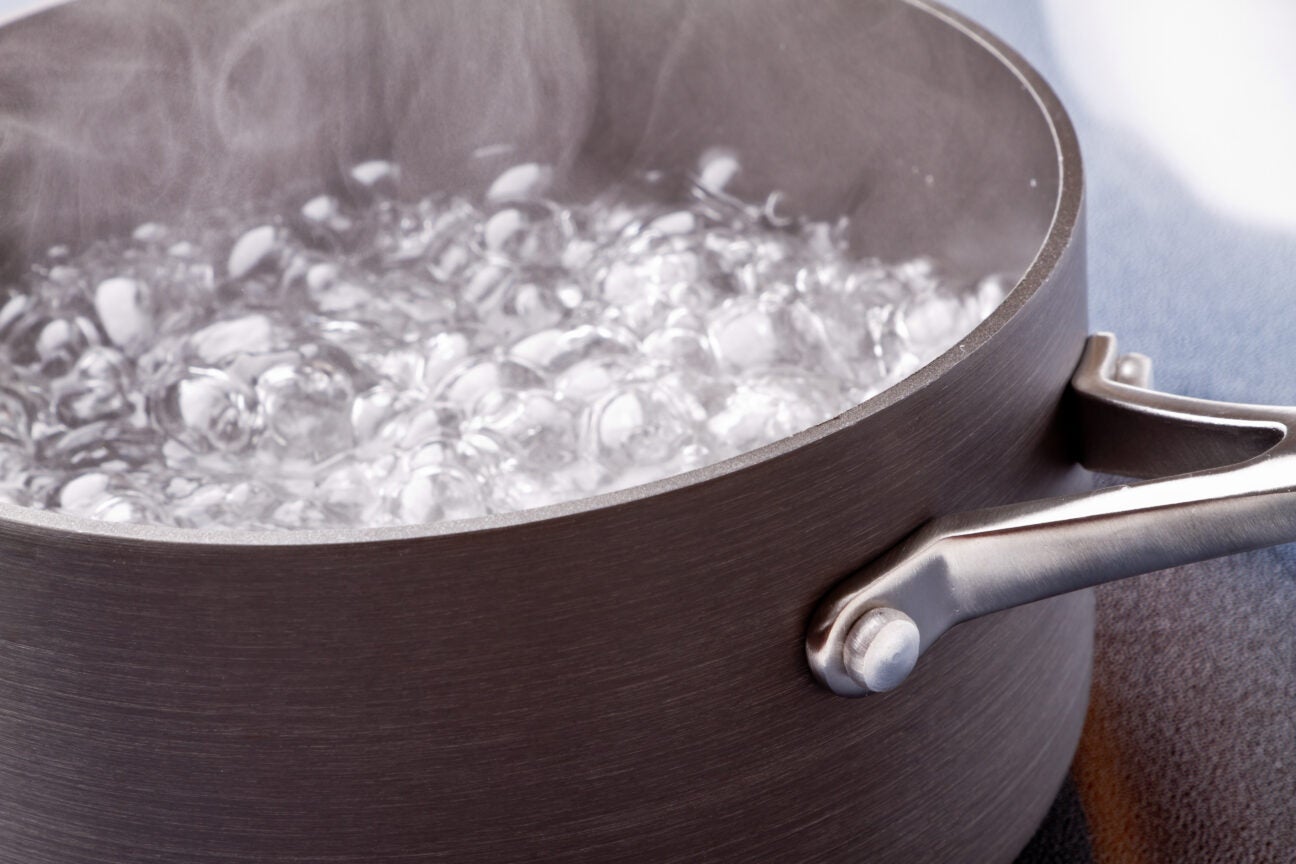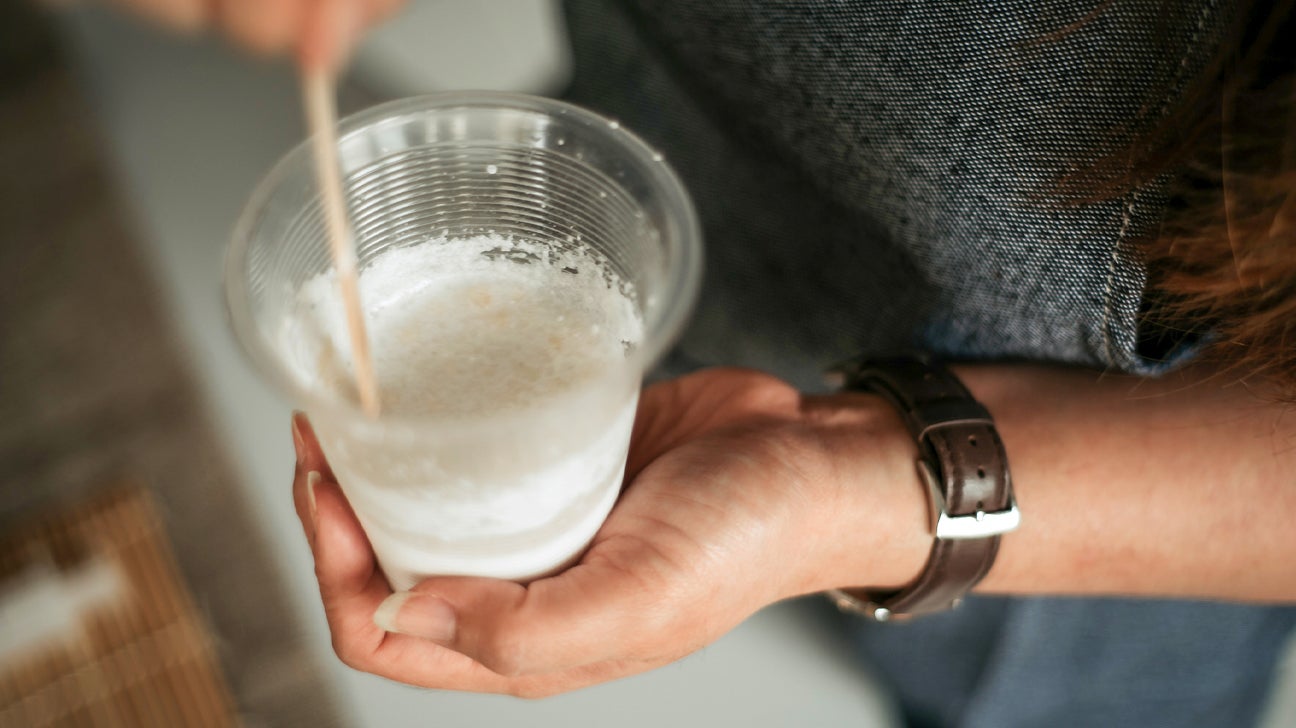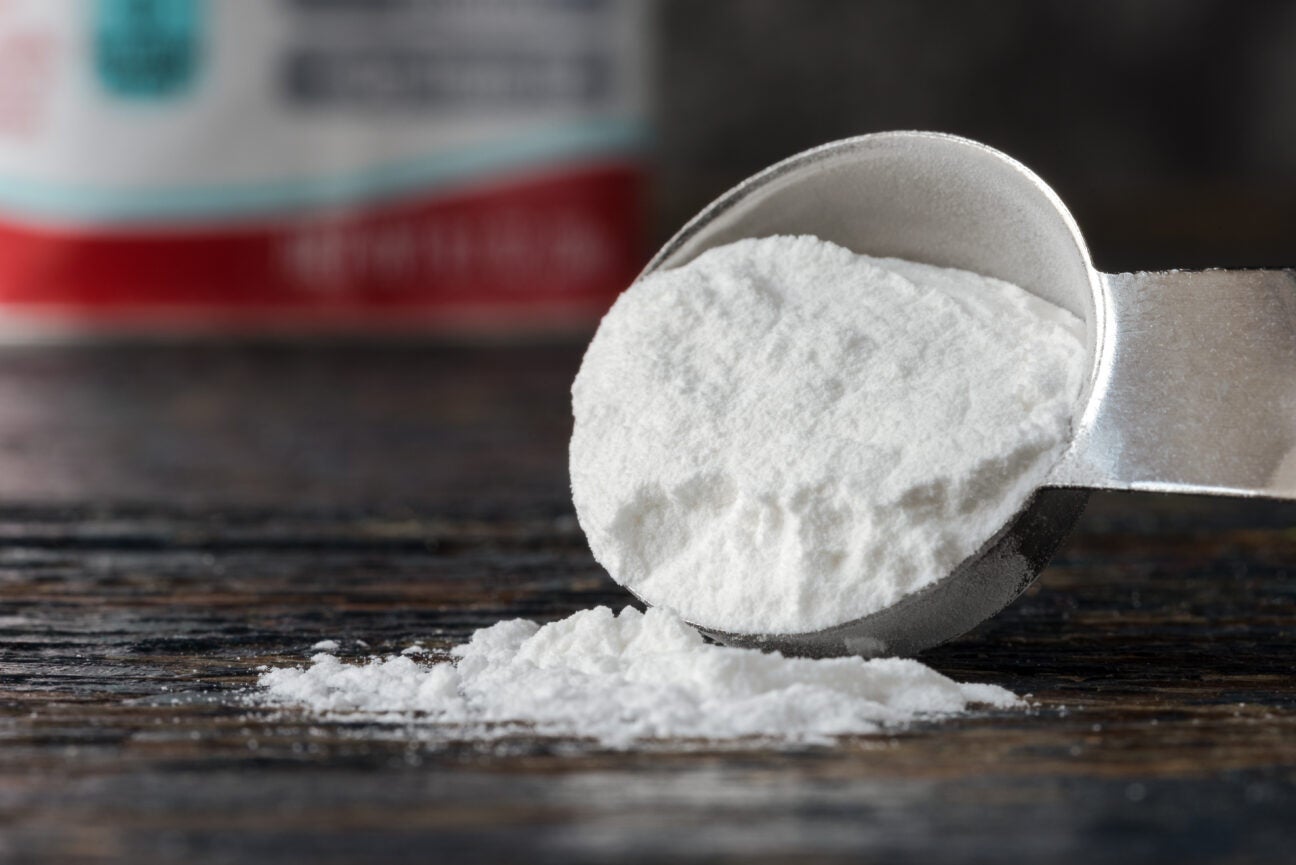One of the more frustrating home dilemmas is a stubborn sink drain that refuses to do its job. Fixing a clog can be as simple as the method you choose, but sometimes choosing the right method ain’t that simple.
Don’t fret — we’ve rounded up seven of the best options that should get things flowing in no time.
7 ways to unclog a sink
- Use boiling water.
- Use a saltwater mixture.
- Use vinegar and baking soda.
- Clear the garbage disposal.
- Clear the P-trap.
- Use a plunger.
- Use a plumber’s snake.

Here’s how you show your clogged sink who’s boss
While it’s tempting to start off with heavy-duty drain cleaners, it’s much safer (and cheaper) to try natural products and household appliances instead.
1. Boiling water

This is the simplest and least expensive method, which makes it a good first option to try. Just be sure to attempt this on metal plumbing only — boiling water can melt plastic pipes and cause leakage.
Here’s how you do it:
- Home warranty company American Home Shield says to first get rid of as much standing water in your sink as possible.
- Dump about a full kettle amount of boiling water down the drain, and then wait for the water to cool.
- If the clog is still present, scoop out as much water as you can and repeat the process. It can take several attempts to work.
2. Saltwater mixture

Here’s another super-easy method that calls for only as much effort as it takes to grab the salt out of the cabinet.
Here’s how you do it:
- Pour 1/2 cup of salt into 1 gallon of water and bring it to a near-boil.
- Pour the mixture down your drain while it’s still hot.
- After 15 minutes, flush the drain with non-salty hot water.
3. Vinegar and baking soda

Don’t try this technique after you’ve already used a chemical drain cleaner. The vinegar may react with the chemicals, causing dangerous fumes (#NotGood).
Here’s how you do it:
- Pour 1/2 cup of baking soda down the drain.
- Add an equal amount of vinegar. The resulting reaction breaks down fats and allows greasy clogs to wash down the drain.
- After 15 minutes, flush the drain with hot water.
4. Check the garbage disposal
Here’s where we leave the pantry and get a little closer to the pipes. A jammed or malfunctioning garbage disposal is commonly the clogging culprit in your kitchen sink.
Here’s how you do it:
- Try running the disposal for 1 to 2 minutes with hot water running at the same time.
- Inspect the inside of the disposal with your hand to make sure no plastic or any other non-food debris has accidentally fallen in. Make sure the disposal is turned off before sticking your hand inside where the grinder is.
- If your disposal won’t turn on, try manually restarting it. The on/off switch is commonly on the side or bottom of the unit under the sink.
5. Clear the P-trap
The P-trap is a nook in the piping that collects water to block sewer gas from seeping up the drain and into your home. This P-shaped pipe can collect debris over time, making regular cleaning a necessity.
Here’s how you do it:
- Clear the area under the clogged sink. Place a container under the trap to catch runoff water.
- There should be two coupling nuts connecting the trap to the drainpipe and overflow pipe. Loosen these and remove the trap.
- Use a rag or a bottle brush to scrub away any blockage from the inside of the trap.
- Once satisfied, reassemble the piping, making sure the bolts are tight. Run the faucet for 30 seconds, watching the trap for any leaks.
6. Use a plunger
Sometimes a stubborn clog needs a helping hand. The old tried-and-true plunger is usually up to most unclogging tasks. It’s nice to have at least two plungers — one for the bathroom and one for the kitchen — to avoid any cross contamination. #Gross
Here’s how you do it:
- Stuff a wet rag in the sink overflow slot to stop air from escaping the tube.
- Place your plunger directly over the drain and be sure there’s enough water to cover the plunger cup.
- Forcefully move the plunger up and down several times to clear the clog.
7. Use a plumber’s snake
This method is for those who have a little more confidence in their home plumbing abilities. A plumber’s snake is a long metal cable with an uncoiled spring on one end and a handle or crank on the other. Unlike the plunger, the snake can wind through pipes and physically break up clogs.
Here’s how you do it:
- Place a container beneath the pipes of your clogged sink to catch runoff. You can also remove the P-trap to make snaking easier.
- If you decide not to remove the P-trap, insert the spring end of the snake into the drain. If you do remove the trap, insert the snake into the access point on the wall.
- Uncoil the snake by rotating the handle at a steady rate. You’ll know you’ve reached the clog when you feel resistance.
- Once you’ve reached the clog, move the handle up and down and back and forth to break up the blockage. If you hear a scraping sound, readjust the snake — heavy snaking can damage your pipes.
- Things should be clear once you feel no more resistance. Pull the snake out and reassemble your pipes.
Why you should steer clear of using chemicals to unclog a sink
Despite offering what might seem like a quick fix, chemical options can have serious drawbacks.
They can be harsh on your pipes
According to Benjamin Franklin Plumbing, commercial drain cleaners often contain harsh chemicals that react with the clog to generate heat and gas. This reaction clears many blockages but does so at the risk of the integrity of your pipes.
Aside from the often-caustic chemicals eating away at your pipes, the heat and gas released can spring leaks in PVC or old pipes.
This is made worse if the cleaner fails to clear a blockage, which could happen with a blockage caused by mechanical failures such as a loose joint fitting or other obstructions. The chemical is left sitting in the pipe with nowhere to go, slowly attacking your plumbing.
They can produce harmful fumes
Many chemicals also release dangerous fumes that can irritate or burn your eyes, lungs, skin, and more. Not to mention the risks of mixing cleaners, like bleach and ammonia, which can create dangerous fumes that lead to potential injury or even death.
Always open a window and make sure there’s good airflow when you’re using chemicals.
They cause more issues outdoors
Chemical cleaners are also damaging to the environment. Cleaner residue can settle into the soil and eventually leak into bodies of water. This is harmful to plants and animals in the area as well as to the people who drink that water.
What causes sink blockage?
According to plumbing and air conditioning company Lindstrom, clogs commonly form from buildup of food, grease, hair, and other small objects washed down the drain.
Kitchen sinks are especially vulnerable to food and grease buildup, especially if you don’t have a garbage disposal. Food can accumulate in the J-trap, and grease can form a sticky coating on your pipes and catch passing objects to form a clog.
Meanwhile, bathroom sinks love to attract hair, which binds with grease or other sticky substances.
No matter the location, sinks are susceptible to buildup of soap scum, dirt, and minerals from hard water. Tree roots are also attracted to tiny leaks in your plumbing and can grow inside your pipes, causing massive blockages. Just guessing, but we don’t think anyone is that big of a plant person.
Why having standing water in your home for too long can be dangerous
So, you might have a case where you either weren’t immediately aware of a clogged sink in your home or you just can’t clear it as quickly as you’d like, leading to a standing water situation. Standing water isn’t just nasty to look at — it could also be hazardous to your health.
It can attract insects
According to plumbing company JD Service Now, stagnant waters are the perfect breeding grounds for all sorts of bacteria and parasites, which could cause serious illness if people or pets drink that water.
Plus, insects like silverfish, cockroaches, and carpenter ants are drawn to standing water. These insects can eat away at the very foundations of your home. Flies and mosquitoes use stagnant puddles as their breeding grounds, and these insects can then spread disease.
It can produce mold
Mold thrives in a wet environment and can then spread throughout your home. Some types of mold are bad for your health, in the worst cases leading to fever, shortness of breath, and more.
It can attract pests
Finally, larger critters like rats are always on the hunt for water sources. Having a long-standing puddle in your home could invite creatures that spread disease and waste.
So even though you might have to get a little slimy, don’t leave standing water in your sink for too long, especially if there are food particles in it.
When to call a pro
According to water damage specialists Rytech, it’s a good idea to call in a professional when you’re dealing with repeated clogs or slow drains.
While it might seem easier to try to correct the issue yourself, don’t start messing around with your pipes if you don’t know what you’re doing or if you’re physically unable to carry out the steps involved. You could end up making the problem worse or even hurting yourself.
Additionally, there’s little need to go over your budget to buy drain cleaners that might end up doing more harm than good. According to Rytech, “Most plumbers discourage use of caustic drain openers that may damage household plumbing, resulting in major repair expenses.”
If you do use a chemical cleaner and it doesn’t resolve a blockage, you may need a plumber’s help.
Tips for keeping your sink drain clear over time
The best way to deal with clogs is to stop them from forming in the first place. Here are some sink etiquette tips to keep your drain squeaky-clean.
DO:
- Use a sink guard to keep your pipes hair- and food-free.
- Regularly clean out the P-trap.
- Consider investing in a garbage disposal to grind up food waste.
- Run cold water when using your garbage disposal to break up fats and grease.
- Run hot water down your drains at least once a week to melt light grease deposits.
DON’T:
- Dump food, coffee grounds, or other organics down the kitchen sink drain if you don’t have a garbage disposal.
- Put grease, fats, bones, or shells down the drain.
- Pour paint, paint thinner, or other hazardous chemicals down your pipes.
Bottom line
Having a clogged sink is frustrating, but it’s not the end of the world. Most of the time, it’s easy to clear up with ingredients you already have in your kitchen or appliances you can buy for minimal cost. But if the problem persists, don’t hesitate to call a professional.
There are many resources out there — Trust a Trader is a great source for finding not just plumbers but also experienced tradespeople near you. Home Advisor also has a huge catalog of local plumbers almost anywhere in the United States.
Whatever method you go with, it’s best to avoid chemicals for the good of your health, your pipes, and the environment.

0 Commentaires